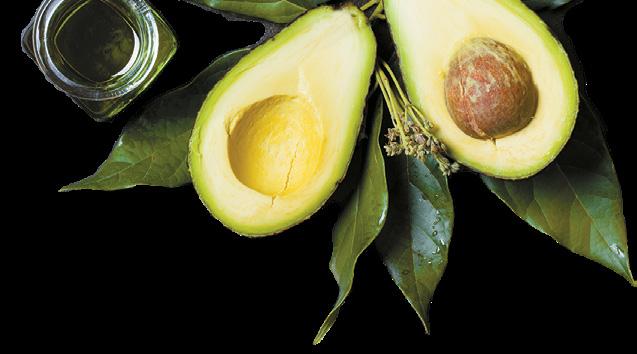
10 minute read
STRONG AND
NOVEMBER Coming Next Month • The Sugar Challenge • Stress Management
Strong and Supple Joints How to Keep Hips and Knees Happy
Advertisement
To advertise or participate in our next issue, call 203-305-5531 PytlakMelissa@gmail.com
by Ronica O’Hara
Occasional knee or hip pain affects tendons and ligaments include fatty fish, almost everyone, keeping us from lentils, nuts, vegetables like spinach and daily tasks, making sitting painful broccoli, and colorful fruit like strawberand walking difficult. Causes can range ries and oranges. from over-exercise to injuries, obesity and arthritis as we age. By the time we reach Practice tai chi, qigong or hatha yoga. 65 years or older, 69 percent of women The gentle, low-impact movements and and 56 percent of men have arthritic stretches associated with these approaches symptoms, according to Boston University get synovial fluid flowing in the larger researchers. Costly joint replacement surjoints, effecting smoother mobility and gery which carries a high risk of adverse increased flexibility; numerous studies effects is often recommended for advanced document that they reduce joint pain and cases, but by taking simple, natural prestiffness. “The key is not just to stretch, ventive and remedial measures proactively, but to balance strength and stretching in we can strengthen our knee and hip joints, a safe, mindful way,” says Andrea Trank, handle related problems if they arise and a health coach and yoga teacher in Fort remain physically strong and active. Myers, Florida. Although personal or class Ways to Strengthen Hips and Knees instruction is best, how-to videos can be found on YouTube. Consume foods that nourish bones and Walk every day. In a four-year Northwestconnective tissues. For strong bones, eat ern University study, people at risk of knee foods rich in calcium, magnesium and osteoarthritis that walked at a moderate or potassium, such as dark leafy greens (bok brisk pace for at least 10 minutes a day, one choy, Chinese cabbage, kale and collard hour a week, had one-eighth the disabled greens), figs, nuts, tofu, avocados and bone mobility of those that walked less. Posbroth. Six prunes a day boosted bone denture helps: Walking straight and tall while sity in women over 70 with osteoporosis, extending each leg back as far as it’ll go will research shows. Foods that support flexible “really let your glut muscles work,” advises
Ways to Lower Pain Levels
Consider the right supplements. Obtaining 1,000 milligrams daily of calcium and 600 international units of vitamin D is essential for bone health, according to the National Institutes of Health; consider taking a supplement if the diet is not adequate. In addition, study-proven options that reduce joint pain in the knees and hips include glucosamine and chondroitin, S-adenosylL-methionine (SAMe) and avocado soybean unsaponifiable.
The benefits of bodywork. A massage can loosen up tight muscles and realign structural issues in the knees and hips while also lowering stress-producing cortisol and raising levels of pain-reducing serotonin. A study at Canada’s McMaster University found that massage works on the cellular level to reduce inflammation and promote the growth of new mitochondria in muscles. Useful styles are Swedish, deep tissue, myofascial release and shiatsu. Ask for references from friends, medical practitioners, fitness centers and natural health stores or find online a certified practitioner with at least 500 hours of training.
Try acupuncture. A new meta-study of 39 studies with 20,827 patients concluded that acupuncture effectively reduces pain for as long as 12 months, and the National Institutes of Health endorses it for knee pain. “It is believed to stimulate the nervous system and in turn, the way the brain registers pain signals,” says acupuncturist Daryl Thuroff, at the Yinova Center, in New York City. Find an acupuncturist at nccaom.org/find-a-practitioner-directory.

jopanuwatd/AdobeStock.com Supplements for Suppleness Glucosamine and chondroitin. Research suggests this combo relieves pain, improves joint mobility and slows arthritic damage to the joints. One study found it benefits up to 70 percent of people with knee arthritis, and a large multinational trial found the mixture to be as effective at reducing pain, stiffness and swelling in knee osteoarthritis as the nonsteroidal anti-inflammatory drug (NSAID) celecoxib. It appears most suited for treating moderate to severe pain and takes two months to take effect.

SAMe. This naturally occurring S-adenosyl-L-methionine molecule builds strong joints by delivering sulfur to cartilage, and research shows it may be as effective as aspirin and ibuprofen at improving joint function. It takes a month to take effect, but doesn’t have the side effects of NSAIDs. It’s also been shown to lower depression.
Avocado soybean unsaponifiable (ASU). Routinely used to treat osteoarthritis in Europe, ASU improves symptoms of hip and knee osteoarthritis (OA) and reduces or eliminates the use of NSAIDs, a meta-analylsis concluded; it also appears to reduce OA’s progression.
Consult a chiropractor. People with osteoarthritic knees that underwent two weeks of chiropractic knee adjustments had substantially less pain, better mobility and fewer grinding and clicking sensations in the knees, reported a study in The Journal of the Canadian Chiropractic Association. In a small study in the Journal of Manipulative and Physiological Therapeutics, four out of five patients with hip arthritis noticed improved symptoms after nine or fewer chiropractic treatments. Many chiropractors offer not only spinal adjustments, but also a range of treatments from exercises to prolotherapy.
Explore injection therapies. Known as regenerative medicine, these therapies use injections in the knee or hip to naturally stimulate the body to produce collagen and rejuvenate tissue. In a British Medical Bulletin meta-study, 82 percent of patients with mild to moderate osteoarthritis of the knee were satisfied with prolotherapy, which uses dextrose injections. Platelet-rich plasma injections use centrifuged platelets from the patient’s body, and have been used by athletes like Tiger Woods and Rafael Nadal to treat sports injuries.
Ronica O’Hara is a Denver-based health writer. Connect at OHaraRonica@gmail.com.
ANSONIA NATURE CENTER
104 acres of wooded hills and grassy fields, miles of nature trails, streams, a two-acre pond, wet meadows, upland swamp, butterfly & hummingbird garden, woodland wildflower and fern garden, community gardening, childrens’ playscape, visitor center, animals & nature exhibits, classes and more!
(203) 736-1053
AnsoniaNatureCenter.org

Cancer-Free Pets Five Ways to Help Keep Them Healthy
by Karen Shaw Becker



Veterinarians are seeing cancer in more and younger pets these days than ever before. According to the American Veterinary Medical Association, approximately one in four dogs will develop cancer at some point in life, including almost half of dogs over the age of 10. But taking practical steps can help lower a pet’s risk. Don’t allow a dog or cat to become overweight.Studies show that restricting the number of calories an animal eats prevents and/or delays the progression of tumor development across species. Fewer calories cause the cells of the body to block tumor growth, whereas too many calories can lead to obesity, which is closely linked to increased cancer risk in humans.
There’s a connection between too much glucose, increased insulin sensitivity, inflammation and oxidative stress, all factors in obesity and cancer. It’s important to remember that fat doesn’t just sit in a pet’s body harmlessly—it produces inflammation that can promote tumor development. Feed an anti-inflammatory diet.Anything that creates or promotes inflammation in the body increases the risk for cancer. Current research suggests cancer is actually a chronic inflammatory disease fueled by carbohydrates. The inflammatory process creates an environment in which abnormal cells proliferate.
Cancer cells require the glucose in carbohydrates to grow and multiply, so work to eliminate this cancer energy source. Carbs to remove from a pet’s diet include processed grains, fruits with fructose and starchy vegetables like potatoes.
Keep in mind that all dry pet food (“fast food”) contains some form of potentially carcinogenic, highly processed starch. It may be grain-free, but it can’t be starch-free because it’s not possible to manufacture kibble without using some type of starch. The correlation between consuming fast foods and cancer has been established in humans, so
it’s wise to incorporate as much fresh, unprocessed food into an entire family’s diet as can be afforded.
Cancer cells generally can’t use dietary fats for energy, so high amounts of good-quality fats are nutritionally beneficial for dogs fighting cancer, along with a reduced amount of protein and no carbs—basically a ketogenic diet.
A healthy diet for a pet is one that’s anti-inflammatory and anti-cancer, and consists of real, preferably raw, whole foods. It should include high-quality protein, including muscle meat, organs and bones. It should also include high amounts of animal fat, high levels of EPA and DHA (omega-3 fatty acids) and a few fresh-cut, low-glycemic veggies. This species-appropriate diet is high in moisture content and contains no grains or starches.
Also make sure the diet is balanced following ancestral diet recommendations, which have much more rigorous standards (higher amounts of minerals and vitamins) than the current dietary recommendations for pets. A few beneficial supplements like probiotics, medicinal mushrooms, digestive enzymes and super green foods can also be very beneficial to enhance immune function. Reduce or eliminate a pet’s exposure to toxins and minimize chronic stress.These include chemical pesticides like flea and tick preventives, lawn chemicals linked to cancer (weed killers, herbicides, etc.), tobacco smoke, flame retardants, household cleaners and air-scenting products like candles and plug-ins. Because we live in a toxic world and avoiding all chemical exposure is nearly impossible, a periodic detoxification protocol can also benefit a pet.
Research points to the benefits of identifying and removing sources of chronic stress in an animal’s life. Focusing on providing environmental enrichment and opportunities for dogs to just be dogs (play, sniff and run) on a daily basis is important in keeping them happy and healthy.
For dogs, especially a large or giant breed, hold off neutering or spaying until the age of
18 months to 2 years. Studies have linked spaying and neutering to increasing cancer rates in dogs. Even better, investigate alternative ways to sterilize a pet without upsetting their important hormone balance. Refuse unnecessary vaccinations. Vaccine protocols should be tailored to minimize risk and maximize protection, taking into account the breed, background, nutritional status, lifestyle and overall vitality of the pet. Vaccines may cause cancer, and titer testing is a responsible way to ensure a pet has adequate immunity in place of over-vaccinating on an annual basis.
Karen Shaw Becker, DVM, a proactive and integrative veterinarian in the Chicago area, consults internationally and writes Mercola Healthy Pets.

serejkakovalev/AdobeStock.com
10 Classic Symptoms Not to Ignore
Dogs and cats can develop cancer almost anywhere in the body, which is why the symptoms vary depending on the tissues and organs involved and the severity of the disease. Make an appointment with a veterinarian if a pet displays any of these warning signs of cancer. 1. Unusual swellings that don’t go away or that grow. The best way to discover lumps, bumps or swelling on a dog or cat is to pet them. 2. Sores that won’t heal. Non-healing sores can be a sign of infection or cancer and should be evaluated by a veterinarian. 3. Weight loss.Illness could be the reason a pet is losing weight when it isn’t on a diet. 4. Loss of appetite. Reluctance or refusal to eat is a sign of possible illness. 5. Bleeding or discharge. Bleeding can occur for a number of reasons, most of which signal a problem. Unexplained vomiting and diarrhea are considered abnormal discharges, as well. 6. Offensive smell. An unpleasant odor is a common sign of tumors of the anus, mouth or nose. 7. Difficulty eating or swallowing. This is a common sign of cancers of the mouth or neck. 8. Reluctance to exercise or low energy level. This is often one of the first signs that a pet is not feeling well. 9. Persistent lameness. There can be many causes of lameness, including nerve, muscle or bone cancer. 10. Difficulty breathing, urinating or defecating. These symptoms should be evaluated by a veterinarian as soon as possible. Many of these symptoms also occur with other disorders and diseases, but any pet showing one or more of these signs needs prompt veterinary attention.





